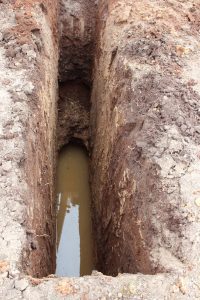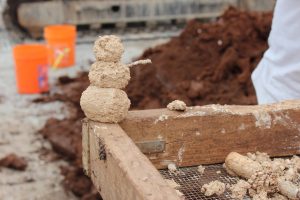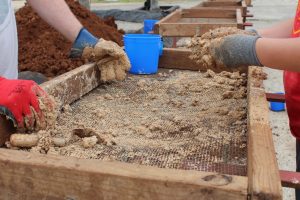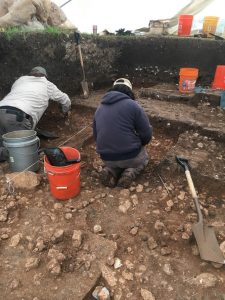Archaeology Update for the Week of March 6
It’s March!
I gotta be honest. When we first planned all of this out, we definitely did not expect the crews would still be out here digging at this point (thanks a LOT, rain, you meanie-head…), but here we are! Looking at the bluebonnets pop up along the countryside in these last couple weeks of the excavation. Maybe the crew can do one of our great Texas traditions and take a ‘family’ photo in them before we finish up out here!

Look out, ladies… or, should I say “Chill out, ladies…” (that’s little ol’ me looking incredibly cool outside of San Antonio around 1983 or so).
Block A is a good ways down now…
Over in Block A, the crew has been working away these past couple weeks and has taken every test unit down to at least 120 centimeters below the surface (just shy of four feet). Some portions of the block actually reached 150 cm (about five feet down). We’re finding that the artifact and feature density is dropping off a bit and the soil has a lot more gravel in it. The gravel is likely from a natural event like a higher-energy flood (more water flowing can carry larger particles). All of these little pebbles and gravels makes distinguishing feature rocks from just rock-rocks – that’s a very scientific term, by the way – a bit more of a challenge, but the team is investigating Feature 59 in these lower depths now.
You can see a lot more of those smaller cobbles and pebbles in the lower depths in Block A.
Remember Block B? There’s actually some news from there!
You may have noticed we’ve been referring to Blocks, A, C, and D but not B. Why’s that? Well, at the very beginning of the excavations we did clear away another excavation block (Block B), but it absolutely refused to dry out after even the slightest rain (you can see a nice photo of genuine Block B dismay in Week 2’s update). That block was essentially abandoned and Block A was expanded to make up the difference and work kept going as you’ve seen.
We had some tantalizing clues from the earlier phases of the project that suggested there was a deeply-buried, very early, Paleoindian site component that could be three meters (9 feet or so) below the modern surface, but we didn’t have any deep excavations to confirm if it was there or not. More recent studies conducted as part of this big excavation indicated that any Paleoindian deposits might actually be deeper than our initial estimate (maybe 15 feet down). To try to find out for sure one way or another if there were deep, Paleoindian deposits at the site the crew set up a large excavator over Block B and dug a deep trench to find out what really was down there.
The answer to that lingering question? “Not much” unfortunately…
The excavator made it more than five meters below the surface and punched through a deeper gravel layer and then the water table. We didn’t find any features at those lower depths. The water table is the depth in soil where groundwater is present. Under most circumstances, the water table is a big “Stop” sign for archaeologists; not necessarily because there won’t be artifacts or features below the water table – in fact there could be – but because it becomes very, very difficult to investigate and essentially impossible to determine what’s intact and what’s mixed around. You can see from the screening photos what a joy it was to try to sort through that muck to find even a single flake. There are ways to do traditional, terrestrial investigations in wet soils or even underwater (check out the Texas Historical Commission’s excavations of la Belle in Matagorda Bay!) but the complexity relative to data return potential make them very rare.
Digging down in Block B.

That’s a lot of water down there…

While I look at this picture and am inspired to pick up mudball fighting, it definitely doesn’t look like a fruitful medium for screening.

The screeners have their artifact bucket on the screen, which indicates they were pulling out the occasional artifact, but overall the artifact counts were not particularly high as they got deeper into the soil.
The Earth Oven Demonstration was a big hit!
You saw us pop in on YouTube a couple Fridays ago with a quick, impromptu earth oven demonstration prep video where we showed everyone the preparations for that evening’s event.
Well, the live demonstration was a great success! We had more than 50 people come and learn how prehistoric people cooked foods in the region. Attendees saw many of the plants that archaeologists have found in ancient cooking features being prepared for baking and some even got the nerve up to try some! The Headwaters’ own Lauren Strack, who’s been out here from the beginning, mentioned how seeing the earth ovens being built made everything make a lot more sense. Wonderful!
Local Boy Scouts got to talk with the lead excavator, Mindy Bonine, about what we’ve been finding, and they got to help build an oven as well. All to earn their Archaeology Merit Badges! It was a lot of fun.
Please tune in tomorrow for our next-to-last Live Video installment from the site. There’s still time to subscribe to the channel and be notified when we go live! We’ll be talking about archaeologists and the bigger picture of what we do. Why we’re here. What we do the rest of the time and more!





